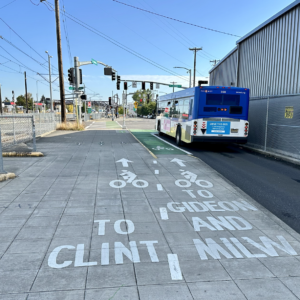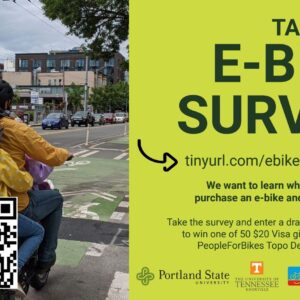Just two weeks after announcing an effort to establish a bicycle boulevard on NE Going Street, the Bicycle Transportation Alliance has scheduled a series of neighborhood meetings for the project.
If your neighborhood association is listed below, make sure to show up and learn more about this effort, ask questions, and get involved.
-
Beaumont-Wilshire Board of Directors
September 08, 7:30pm
Bethany Lutheran Church
NE 37th and NE Skidmore
Beaumont-Wilshire Neighborhood Association
October 13th, 7:30pm
Beaumont Middle School
NE Freemont and NE 42nd
Humboldt
September 09, 7pm
PCC Public Service, Education Building room 101
909 N Killingsworth
Sabin Community Association
October 20th, time and location TBA
Cully Association of Neighbors
November 11th, 7pm
6025 NE Prescott
King
November 12th, 6:30pm
King Neighborhood Facility
4815 NE 7th
Boise Neighborhood Association & Alameda Neighborhood Association
TBA
Concordia
Check neighborhood newsletter for updates on campaign.
Click here for more information on the BTA’s “Let’s Get Going!” campaign.







Thanks for reading.
BikePortland has served this community with independent community journalism since 2005. We rely on subscriptions from readers like you to survive. Your financial support is vital in keeping this valuable resource alive and well.
Please subscribe today to strengthen and expand our work.
I live in the Vernon Neighborhood. When I ride home, I go up Williams and hang a right on Alberta until 15th Ave.
When you first wrote that they were thinking about making Going a bike boulevard, I turned right on Going the next day… and I have not ridden down the street again.
Going is littered with stop signs and, even worse, an unregulated intersection at MLK. Cars won\’t even stop when you get off your bike and try to walk into the intersection.
The only way to make Going a successful bike boulevard, they will need to eliminate almost all stop signs and make a traffic signal at Going with bike sensors.
People will choose the path with least resistance… just look at the Rose Quarter Transit Center.
\”Let\’s Get Going\” is so cheesy that it\’s actually going to work.
i live in king, and typically continue up n williams to alberta, and then wiggle over to killingsworth through side streets – however, if im stopping somewhere on alberta on the way home, i typically use going rather than riding up alberta, cause hey – i get enough riding in traffic at work, and im fond of side streets.
though ive never really had any problems crossing mlk on going, i can see where a signal there might be a boon for many a cyclist – but removing all stop signs all the way up going? i mean *really*. what is it that makes stopping so objectionable? is being able to blast through, head down, racing along, not worrying about cross traffic that important to a bike commute? do we need bike boulevards to actually be bike autobahns?
dana,
you\’re exactly right. but part of the idea of the bike boulevard is to turn some of those stop signs around and add some traffic calming devices. i wouldn\’t discount it just yet.
Joel,
That\’s bikebahns…
And no, we don\’t need bike boulevards to be that. I think we shouldn\’t. It\’s poor P.R. for our cause.
We should, however, build bikebahns as well.
How much could a bikebahn mile cost? Continuous path, elevation and weather conditioned, interstate style junctions, four [bike] lanes…
Engineers? Other smarty-pantses?
This, too, would be good P.R. I\’ve long held the belief that people ultimately desire efficiency, mostly regardless of side effects.
If we can make side effects the selling point on an efficiency par…
I just hope that this doesn\’t mean any less attention is paid to Skidmore. I think that\’s where the bike boulevard should be going. At least Skidmore has signals at MLK, Williams, and Vancouver. It even goes over I-5 and past interstate.
Even just some turned stop signs would be appreciated so long as it didn\’t encourage cars to cut through.
Way to go, BTA!
To John, #6, Eliminating cars cutting through isn\’t that hard. Just look at the SE Clinton bike boulevard. The speed bumps cause drivers to think twice about using Clinton as a shortcut and those bumps really don\’t impede cyclists in any significant way.
Ron (#7) – I don\’t know that Clinton is such a great example. Sure, it\’s a wildly successful bike boulevard, but it sees a large amount of cut-through traffic trying to avoid Division, enough that the city is discussing and planning signage and other potential measures to encourage cars to stay off Clinton.
Let\’s get going, then lets get Holman!
Joel, we actually would need to turn those stop signs. I don\’t want to ride down a street with them. And John is right, lets discourage traffic. How about HAWK signals at MLK, force traffic at 15th and 33rd off of going (think 20th and Ankeny), and we will see Many more cyclists enjoying going. Now let\’s get Holman St!
According to Wiki:
A bicycle boulevard is a shared roadway which has been optimized for bicycle traffic. In contrast with other shared roadways, bicycle boulevards discourage cut-through motor vehicle traffic, but typically allow local motor vehicle traffic. They are designed to give priority to cyclists as through-going traffic.
Bicycle boulevards are designed to offer the advantages of cycling on shared arterials roadways that experienced cyclists typically value, combined with the advantages of bicycle paths that appeal to would-be, inexperienced, or young riders. Thus, bicycle boulevards can be beneficial to both types of cyclists. Experienced cyclists can enjoy lower traffic without significant increases in trip time. For less experienced cyclists, bicycle boulevards can serve as \”stepping stone\” facilities that help them move from bicycle paths and trails onto shared roadways.
Bicycle boulevards use a variety of traffic calming elements to achieve a safe environment. For instance, diverters with bicycle cut-outs at mid-block allow motorists to enter the block in order to park or otherwise access a property, and allow cyclists to continue to the next block as well, but do not allow motorists to continue. Typically, these modifications are thought to calm traffic and improve pedestrian safety as well as encouraging bicycling.
The purpose of a bicycle boulevard is to improve bicycle safety and circulation by having or creating one or more of the following conditions:
* low traffic volumes (or bike lanes where traffic volumes are medium);
* discouragement of non-local motor vehicle traffic;
* free-flow travel for bikes by assigning the right-of-way to the bicycle boulevard at intersections wherever possible;
* traffic control to help bicycles cross major arterial roads; and
* a distinctive look and/or ambiance such that cyclists become aware of the existence of the bike boulevard and motorists are alerted that the roadway is a priority route for bicyclists.
Examples exist in a few cities, including Berkeley, California; Emeryville, California, Palo Alto, California; San Luis Obispo, California; Portland, Oregon; Eugene, Oregon; and Vancouver, British Columbia. Generally speaking, any street that is a potential rat run for motorists can be converted to a bicycle boulevard.
In Berkeley, California the boulevards are mostly residential streets, however some sections pass through commercial areas. Generally there are few cars on these streets, in large part because of the pre-existing traffic calming devices that slow and/or divert traffic. Bicycle boulevards may or may not have bicycle lanes.
Critics of bicycle boulevards and other types of bike routes, such as John Forester, have argued that they encourage cyclists to be seen as inferior by consigning them to poor quality roadways and discouraging them from riding on major arterial roads. Instead, they argue for the concept of vehicular cycling, positing that cyclists are safer when they behave like drivers of any other vehicles, ride in full traffic, and follow traffic laws accordingly. Bicycle boulevards often have higher road surface standards than other residential streets, and encourage riders to use the full lane as necessary, bringing roadway parity to bicycles and motor vehicles. [1]
In the Netherlands city of Amsterdam, around 40% of journeys are by bicycle, and planners at the Directorate Infrastructure Traffic and Transport [2] have adopted a bicycle policy that blends segregated bicycle lanes with in-traffic, \”bicycle boulevard-style\” cycling. The general rule is that cyclists can integrate safely with traffic traveling at or below 30 km/h (19 mph), but that segregated bike lanes should be installed along roads with a higher speed limit. With these policies in place, Amsterdam remains one of the more active cycling cities in the world.
Does anyone know if these meetings are only about NE Going? I know that the BTA was looking into establishing a network of boulevards in NE and I\’m interested to hear about how the larger effort is (pardon my pun)going?
Hey BTA,
I am the co-chair for the Concordia Neighborhood Association. To my knowledge, we haven\’t heard from you on this at all. I know I haven\’t.
So don\’t be shy. Give me a holler if you want to be on a future meeting agenda. My contact info can be found here:
http://concordiapdx.org
And to all the residents in Concordia out there. In addition to the printed newsletter, we post more info on the neighborhood association blog and the address above, or click on my name.
All the best,
Tony Fuentes
Hey BTA,
Thanks the quick response to my comment! We will get something going in Concordia and let Mr. Maus know.
All the best,
Tony
This all sounds well and good, but how exactly is it going to be paid for? Is the city of Portland going to require licenses for bicycles? Are police going to be ticketing bicyclists more often?
Its great that you folks are so interested in changing things for the better, but I think we really need to look at the costs before we so quickly trumpet the benefits.